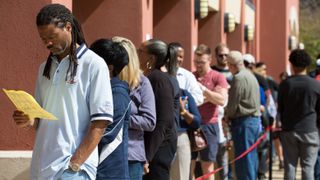In two weeks, Americans will go to the polls for the first national election of the Trump era. The midterms will be a pivotal election. As the two major parties grow further apart, and with Democrats nominating record numbers of women and minority candidates, the election offers an opportunity for voters to weigh in on distinctly different visions of America.
But will the results reflect the will of American voters?
It is a crucial question, one centred not on interference by Russians – although Russian attempts to interfere in the midterms have been under way all year – but by Republicans. And while liberals have doubled down in their efforts to register voters and turn out the vote, they face an uphill battle as the GOP goes to further and further lengths to prevent Democrat voters from casting their ballots.
While liberals have doubled down in their efforts to register voters and turn out the vote, they face an uphill battle as the GOP goes to further and further lengths to prevent Democrat voters from casting their ballots.
Worries about voter suppression have spread across the country. In Georgia, where Democrat candidate Stacey Abrams could become the first black woman to serve as governor in the rapidly changing state, the Republican Party has gone to great lengths to keep black voters from the polls. Brian Kemp, the Republican candidate for governor, currently serves as the secretary of state, which means he oversees all elections in the state. In recent months he’s purged or suspended the registration of more than 50,000 voters – 70 per cent of whom are African American, although the black population of Georgia is only around 32 per cent.
In the past six years more than 200 polling places have been closed in Georgia. Because of those closures, early-voting lines have swelled, leaving voters in line for more than three hours. And when 40 black seniors arrived at the polls on a bus organised by the Black Voters Matter Fund, they were denied their ballots by a poll worker citing “partisanship” (though the fund is a nonpartisan organisation).
Suppression efforts come in all shapes and sizes, and can be difficult to track, since most election law is set at the local and state level, not by the national government. In Kansas, where Kris Kobach, an anti-immigration Republican intent on limiting voting access is currently running for governor, voting inequality is high.
Most districts in Kansas have polling places that serve an average of 1200 voters. Dodge City, Kansas, though, which is now 60 per cent Hispanic thanks to the two large meat-packing plants that opened in the city, has only one polling site for its 13,000 voters. That polling place used to be by the town’s exclusive country club, where the white, wealthy residents live. Now it’s been moved out of town, more than a mile from the nearest bus stop.
Suppression efforts come in all shapes and sizes, and can be difficult to track, since most election law is set at the local and state level, not by the national government.
There may be 13,000 voters on the rolls in Dodge City, but it would be quite a stretch to suggest all 13,000 of those voters have the ability — and thus, the right — to vote.
Voter suppression has been a key component of the Republican platform for the better part of a decade now. As the American electorate has grown less white and less conservative, the GOP has focused not on expanding its voter base but on shrinking the Democrats’. Suppression has come in all shapes and sizes: closing polls, passing restrictive voter ID laws, limiting early voting, purging voter rolls.
When Republicans first attempted to restrict voting rights, they ran into a serious problem: the Voting Rights Act. First passed in 1965 and reauthorised as late as 2006, the act countered racial bias in voting laws. For instance, states and localities with a history of discriminatory voting laws had to get pre-clearance for any proposed voting changes, an extraordinary exception to the country’s deference to state voting laws.
In 2006, the Voting Rights Act passed the Senate 98-0, making the Supreme Court the last resort for those hoping to suppress votes. And the Court obliged in 2013, gutting the Voting Rights Act in Shelby Co. v. Holder. Since then, efforts to suppress votes have flourished across America, and a country that prides itself on its democratic tradition has become increasingly illiberal in its voting laws, with an entire political party devoted to shrinking the voting pool.
In the early days of GOP voter suppression, Republicans relied on the voter-fraud canard, the false claim that Democrats were bolstering their election day outcomes through fraudulent votes. Study after study has shown that in-person voter fraud is exceedingly rare, and lately we’ve heard little about it (though keep an eye on Donald Trump’s Twitter feed over the next month or so). But in the face of a genuine threat to American elections — Russian interference — Republicans did nothing, refusing to speak out about the threat in 2016 and hesitant to devote resources to election integrity in the years since.
What all this means is not that Democrats will be crushed in the midterm elections – they almost certainly will have a historic night. But it does mean that come Election Day, thousands if not millions of Americans who want to vote for their vision of America will be denied their chance – and the nation’s slide toward illiberalism will continue, whatever the results.






